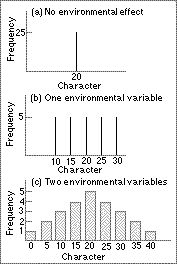Quantitative genetics - Why do some characters have a 'bell curve' distribution?

Polygenic characters
Quantitative genetics is concerned with characters influenced by many genes, called polygenic characters. For a quantitative geneticist, five to 20 genes is a small number of genes to be influencing a character; whereas many quantitative characters may be influenced by more than a hundred, or even several hundred, genes. For characters influenced by a large number of loci, it ceases to be useful to follow the transmission of individual genes or haplotypes (even if they have been identified) from one generation to the next. The pattern of inheritance, at the genetic level, is too complex.
Many environmental influences
So far we have only considered the effect of genes. The value of a character, like beak size, will usually also be influenced by the environment in which the individual grows up. All characters to do with bodily stature will be influenced by the amount of food an organism happens to find during its life. If we take a set of organisms with identical genotypes and allow some to grow up with abundant food and others with limited food, the former will end up larger on average. In nature, each character will be influenced by many environmental variables, some tending to increase it, others to decrease it. Thus environmental influences also maintain a 'bell shaped' frequency distribution.
Quantitative genetics employs higher-level genetic concepts that are genetically less exact than those of one or two-locus population genetics, but which are more useful for understanding evolution in polygenic characters. Instead of following changes in the frequency of genes or haplotypes, we now follow changes in the frequency distribution of a phenotypic character. Quantitative genetics is important because so many characters have continuous variation and multi-locus control.
The biologist Richard Lewontin explains why genetic information alone is not enough to infer an organism's phenotype.
Figure: environmental effects can produce continuous variation. (a) Twenty-five individuals in the absence of environmental variation all have the same phenotype with a value for a character of 20. (b) With one environmental variable. The variable has five equally probable states, each of which change the character by a diffferent amount. (c) A second environmental variable which also changes the character. With more variables, the frequency distribution curve becomes more bell shaped.
| Next |



